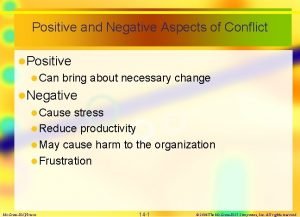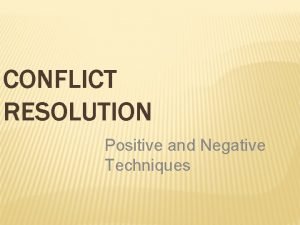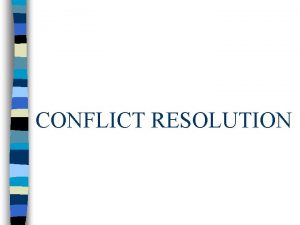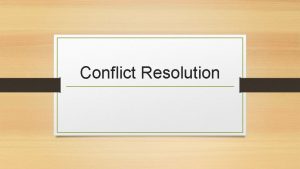Conflict Resolution Positive and Negative Techniques Preparation Include









- Slides: 9

Conflict Resolution Positive and Negative Techniques

Preparation • • • Include only those concerned. Give a description of the problem that respects all involved. Explain how conflict resolution can enable all to win, and explain the steps. Agree not to slip back to the win lose methods Find a good time and place with no distractions. Get something to write down ideas.

Identify the problem or issues Use “I” Messages to explain your own concerns, needs and basic goals • Use reflective listening to hear and acknowledge the other’s needs and basic goals • Evaluate exactly what each of your actual needs are with the problem. List needs. • Don’t accept sudden promises not to cause the problem •

Brainstorm All Possible Solutions that meets both people’s needs Cake Cutting Exercise You are in charge of a Birthday party for four Children. You have one Cake and need to cut it in 4 equal parts. Brainstorm with your partner How many different ways you could cut it. Car Sharing Solution You and your spouse have one car. You need to go to a meeting tonight, and your spouse wants to visit a good friend. How many solutions can you come up with? Look at things from another’s perspective and try to see their point of view and look for a solution that meets both underlying needs.

Brainstorm to Generate all possible solutions. n · Think of any and all possible ways to solve the problem so that everyone will have needs met. n · Evaluate later NOT NOW n · Do not criticize any suggestion. Feed back with reflective listening n · Write down all ideas suggested.

Evaluate the alternative solutions Ask “Will it work? Does it meet all the needs of both people? Are there any problems likely? ” • Don’t accept solutions for the sake of speed • Use reflective listening and I Messages •

Decide on the best solution. Find a solutions that is mutually acceptable to both of you. . • If agreement seems difficult, Summarize areas of agreement. Restate needs, and look for new solutions. • Make certain that both of you are committed to the solution •

Implementing the Solutions Get Agreement on who does what by when • Write this down and check all agree to it • Refuse to remind or police the solutions • If you want to set criteria for success, work out these now •

Follow-up evaluation Carry out agreed method. Wait to see if the conflicts seems resolved. • If the agreed upon solution doesn’t work, remember it is the solution that failed, not the person, and seek for a new solution. n Ask from time to time if the solution is working for both of you. •
 What is conflict and conflict resolution?
What is conflict and conflict resolution? #include stdio.h #include conio.h #include stdlib.h
#include stdio.h #include conio.h #include stdlib.h Include stdlib h
Include stdlib h Positive and negative conflict
Positive and negative conflict High resolution low resolution
High resolution low resolution Center for african peace and conflict resolution
Center for african peace and conflict resolution Guy de maupassant the necklace setting
Guy de maupassant the necklace setting Watch mastering conflict management and resolution at work
Watch mastering conflict management and resolution at work















